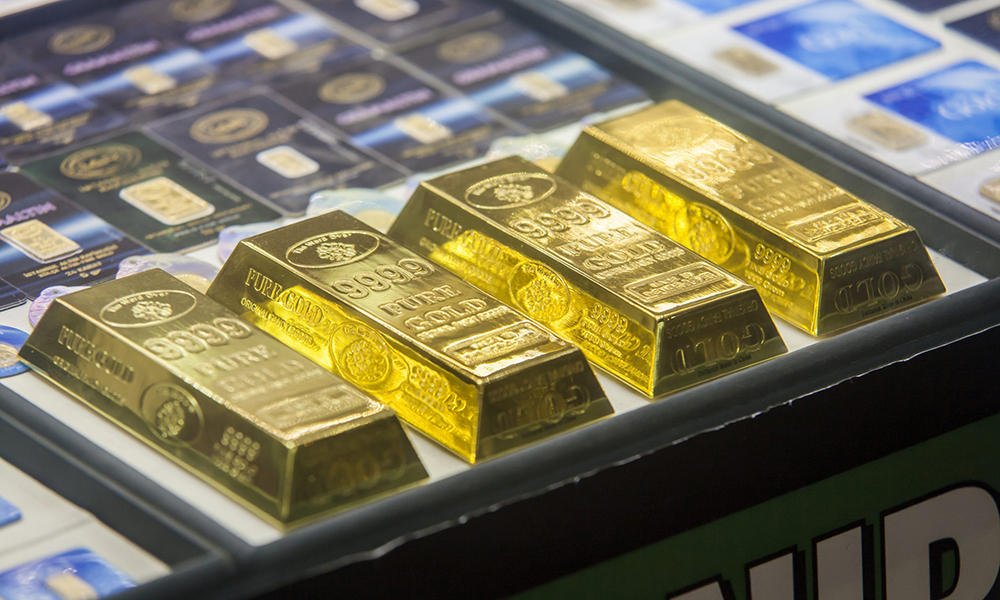
高盛(Goldman Sachs)的一项研究显示,日益紧张的贸易局势和对美国财政资产负债表可持续性的担忧,可能会在未来一年导致金价上涨。
今年10月底,贵金属黄金的价格在盘中创下了2,790美元的历史新高,当时世界黄金协会(World Gold Council)在其季度需求趋势报告中警告称,市场已经屈服于“错失恐惧症”(FOMO)。此后,金价在11月有所回落,目前交易价格约为2,600美元。
高盛在上周日发布的2025年大宗商品展望研究报告中表示:“美国大选尘埃落定之后,金价从接近历史高位的投机仓位回调,这为买入黄金提供了一个良机。”
高盛预计,在拜登政府冻结俄罗斯资产后,各国央行纷纷寻求将外汇储备永久多样化,放弃当前的美元配置,从而使对黄金的潜在需求强劲。一些银行认为,黄金是一种更具政治中立性的资产,不会因为地缘政治风险而被各国冻结。
高盛预测,由于投资者的周期性资金流入(投资者希望对冲美联储明年将利率降至3.25%至3.5%对投资组合的预期影响),交易所交易基金也将推高金价。
到2025年年底,金价可能会上涨到每盎司3,150美元
因此,高盛预测,到明年年底,金价应该会达到每盎司3,000美元。
但现在高盛估计,随着特朗普的过渡团队不断以其非正统的政策和内阁人事任命震惊市场,地缘政治风险可能促使最近仍活跃的投机者回归。
美国经济是否会在巨额财政赤字日益难以为继的情况下,对其贸易伙伴加征惩罚性关税?随着投机者开始押注,这可能会将黄金价格推升至每盎司3,150美元。
黄金对由政府法定货币支持的纸币投了不信任票
在截至9月份的上一财年,美国政府不得不通过额外借款填补1.83万亿美元的预算赤字,如果美联储被迫用新印的美钞购买更多美国国债,这可能会导致通货膨胀。
高盛的报告写道:“对通货膨胀和财政风险的日益担忧,可能导致投机仓位增多,更多资金流入交易所交易基金。而美国债务的可持续性问题可能会促使各国央行,特别是持有大量美国国债储备的央行,购买更多黄金。”
虽然一些特定因素,包括央行积极管理其黄金储备配置或印度等主要珠宝市场的需求等,可能推动购买黄金的热潮,但在不确定时期,黄金价格的普遍持续上涨,通常被视为对美元的储值功能投下了不信任票,以及对其他仅由政府法定货币支持的纸币的不信任票。
特朗普的关税政策可能使普通美国家庭每年的支出增加2,600美元
在人们普遍担忧特朗普上任可能给消费物价带来上行压力之际,对美元不受信任的担忧日益加剧。当选总统特朗普喜欢对钢铁等进口商品挥动关税大棒,在必要时,他可能引用国家安全威胁的法律论据,通过行政命令单方面征收关税。
高盛写道:“在特朗普的第二个任期,供给侧的通胀上行风险主要源于更高的关税。”
例如,特朗普曾表示要对进入美国市场的所有商品全面征收高达20%的关税,对中国商品则征收60%的特殊关税。彼得森国际经济研究所(Peterson Institute for International Economics)估计,这可能会使美国家庭的平均年支出增加2,600美元。
美联储制定政策的独立性受到了攻击
对特朗普的关税政策不满的其他国家将面临一个难题,因为自2019年12月美国在特朗普任期内首次否决世界贸易组织(World Trade Organization)上诉机构的新人事任命以来,该争端解决法庭便一直处于“停摆”状态。
同样令人担忧的是,特朗普坚持认为,除财政政策外,白宫还应该拥有对货币政策的直接发言权,这实际上等于终结了美联储的政治独立性。在打破这一壁垒的国家,如土耳其,这样做可能会导致通货膨胀螺旋上升。
随后,黄金价格一路飙升,400盎司标准金条的价格最近达到了每条100万美元。(财富中文网)
译者:刘进龙
审校:汪皓
高盛(Goldman Sachs)的一项研究显示,日益紧张的贸易局势和对美国财政资产负债表可持续性的担忧,可能会在未来一年导致金价上涨。
今年10月底,贵金属黄金的价格在盘中创下了2,790美元的历史新高,当时世界黄金协会(World Gold Council)在其季度需求趋势报告中警告称,市场已经屈服于“错失恐惧症”(FOMO)。此后,金价在11月有所回落,目前交易价格约为2,600美元。
高盛在上周日发布的2025年大宗商品展望研究报告中表示:“美国大选尘埃落定之后,金价从接近历史高位的投机仓位回调,这为买入黄金提供了一个良机。”
高盛预计,在拜登政府冻结俄罗斯资产后,各国央行纷纷寻求将外汇储备永久多样化,放弃当前的美元配置,从而使对黄金的潜在需求强劲。一些银行认为,黄金是一种更具政治中立性的资产,不会因为地缘政治风险而被各国冻结。
高盛预测,由于投资者的周期性资金流入(投资者希望对冲美联储明年将利率降至3.25%至3.5%对投资组合的预期影响),交易所交易基金也将推高金价。
到2025年年底,金价可能会上涨到每盎司3,150美元
因此,高盛预测,到明年年底,金价应该会达到每盎司3,000美元。
但现在高盛估计,随着特朗普的过渡团队不断以其非正统的政策和内阁人事任命震惊市场,地缘政治风险可能促使最近仍活跃的投机者回归。
美国经济是否会在巨额财政赤字日益难以为继的情况下,对其贸易伙伴加征惩罚性关税?随着投机者开始押注,这可能会将黄金价格推升至每盎司3,150美元。
黄金对由政府法定货币支持的纸币投了不信任票
在截至9月份的上一财年,美国政府不得不通过额外借款填补1.83万亿美元的预算赤字,如果美联储被迫用新印的美钞购买更多美国国债,这可能会导致通货膨胀。
高盛的报告写道:“对通货膨胀和财政风险的日益担忧,可能导致投机仓位增多,更多资金流入交易所交易基金。而美国债务的可持续性问题可能会促使各国央行,特别是持有大量美国国债储备的央行,购买更多黄金。”
虽然一些特定因素,包括央行积极管理其黄金储备配置或印度等主要珠宝市场的需求等,可能推动购买黄金的热潮,但在不确定时期,黄金价格的普遍持续上涨,通常被视为对美元的储值功能投下了不信任票,以及对其他仅由政府法定货币支持的纸币的不信任票。
特朗普的关税政策可能使普通美国家庭每年的支出增加2,600美元
在人们普遍担忧特朗普上任可能给消费物价带来上行压力之际,对美元不受信任的担忧日益加剧。当选总统特朗普喜欢对钢铁等进口商品挥动关税大棒,在必要时,他可能引用国家安全威胁的法律论据,通过行政命令单方面征收关税。
高盛写道:“在特朗普的第二个任期,供给侧的通胀上行风险主要源于更高的关税。”
例如,特朗普曾表示要对进入美国市场的所有商品全面征收高达20%的关税,对中国商品则征收60%的特殊关税。彼得森国际经济研究所(Peterson Institute for International Economics)估计,这可能会使美国家庭的平均年支出增加2,600美元。
美联储制定政策的独立性受到了攻击
对特朗普的关税政策不满的其他国家将面临一个难题,因为自2019年12月美国在特朗普任期内首次否决世界贸易组织(World Trade Organization)上诉机构的新人事任命以来,该争端解决法庭便一直处于“停摆”状态。
同样令人担忧的是,特朗普坚持认为,除财政政策外,白宫还应该拥有对货币政策的直接发言权,这实际上等于终结了美联储的政治独立性。在打破这一壁垒的国家,如土耳其,这样做可能会导致通货膨胀螺旋上升。
随后,黄金价格一路飙升,400盎司标准金条的价格最近达到了每条100万美元。(财富中文网)
译者:刘进龙
审校:汪皓
Escalating trade tensions and concerns over the sustainability of the U.S. fiscal balance sheet could help ignite a fire under the price of gold in the coming year, according to a study by Goldman Sachs.
The precious metal hit an intraday all-time high of $2,790 of at the end of this October, when the World Gold Council warned in its quarterly demand trend report that the market had succumbed to FOMO—or fear of missing out. It has since pulled back over the course of November, and is trading at around $2,600 currently.
“The gold price consolidation following the orderly U.S. election—flushing speculative positioning from near all-time highs—provides an attractive entry point to buy gold,” it said in a research note on the 2025 outlook for commodities published on Sunday.
Goldman Sachs expects robust underlying demand for bullion among central banks looking to permanently diversify their reserves away from their current allocation of U.S. dollars after the Biden administration froze Russian assets as punishment for the invasion of Ukraine. Some banks see gold as a more politically neutral asset that can’t be subject to freezes by countries because of geopolitical risk.
Exchange-traded funds will also bid up the price, Goldman predicted, due to cyclical inflows from investors seeking to hedge their portfolios against the forecast effect of the Federal Reserve lowering interest rates to between 3.25% and 3.5% next year.
Bullion could rise to $3,150 an ounce by end of 2025
As a result, gold bullion ought to be trading at $3,000 per ounce by the end of next year, the Wall Street investment bank believes.
But now the bank estimates geopolitical risks could prompt speculators, who were active up until very recently, to return as Trump’s transition team continues to shock markets with its unorthodox policies and Cabinet appointments.
This could lift gold to $3,150 an ounce as speculators begin to take bets on whether the U.S. economy will saddle its trading partners with new punitive tariffs just as the country struggles increasingly to shoulder its immense fiscal deficits.
Gold’s vote of no confidence in paper currencies backed by government fiat
The $1.83 trillion budget shortfall from this past fiscal year through September had to be met with additional borrowing, which can be inflationary should the Fed be forced to purchase more U.S. Treasury notes with freshy printed dollars.
“Rising fears of inflation and fiscal risks could drive speculative positioning and ETF flows higher,” it wrote, “while U.S. debt sustainability concerns may push central banks, especially those holding large U.S. Treasury reserves, to buy more gold.”
While idiosyncratic aspects can drive gold buying—including central banks actively managing their allocation of gold reserves or demand in key jewelry markets like India—a broad sustained rise in the gold price during periods of uncertainty is often viewed as a vote of no confidence in the U.S. dollar as a store of value, as well as and other paper currencies backed solely by government fiat.
Trump’s tariffs could cost the average American household $2,600 a year
This concern has gathered steam amid the widespread concern that Trump’s tenure could put upward pressure on consumer prices. The President-elect already has a fondness for slapping tariffs on imported goods like steel—if necessary by relying on legal arguments citing a threat to national security in order to impose them unilaterally via executive order.
“The key upside risks to inflation under the second Trump administration on the supply side are much higher tariffs,” Goldman wrote.
For example, Trump has spoken about setting tariffs across the board on every good brought into the market as high as 20%, with a special 60% tariff on Chinese goods. The Peterson Institute for International Economics estimates this could drive the average annual spend up by $2,600 for U.S. households.
Federal Reserve’s independence to set policy under attack
Governments unhappy with this would have a difficulty as the World Trade Organization’s dispute settlement tribunal, the Appellate Body, has been dormant ever since December 2019, when the U.S. first began vetoing new appointments under Trump.
Just as worrying has been his insistence that the White House gain a direct say on monetary policy in addition to fiscal policy, de facto ending the Federal Reserve’s political independence. In countries where this barrier has been breached, like Turkey, it can lead to spiraling inflation.
Gold has subsequently been on a tear, with the cost of a standard 400-ounce gold bar recently hitting $1 million each.






